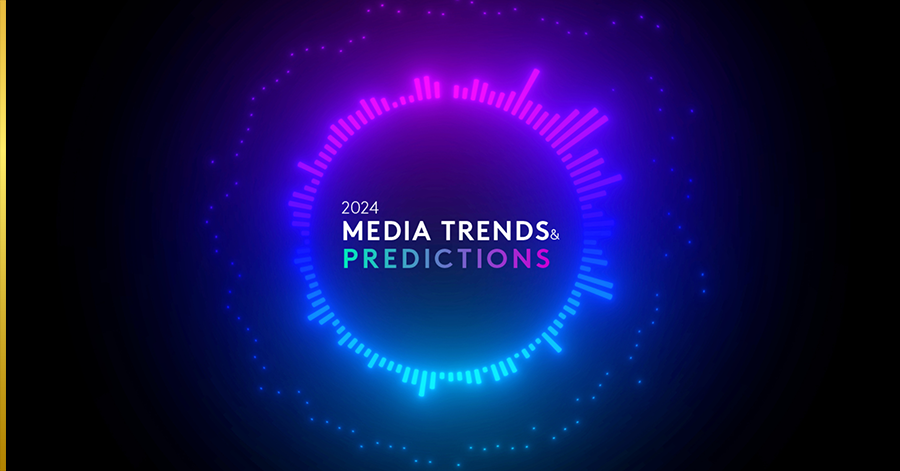
Kantar releases its 2024 media trends and predictions report
Content goes back to the future and supercharged audience insights unlock value
Sydney, 8 November 2023: Kantar has released its global 2024 Media Trends and Predictions report based on the market insights it has developed for clients around the world. In exploring the forces shaping the media landscape, Kantar’s Media experts predict that macro-economic factors and changing viewing habits will have profound impacts on the media industry in 2024, resulting in a renewed focus on library content and expanded approaches to audience measurement.
There are five key global industry trends shaping 2024.
1. Ad-supported streaming will flourish amid inflation
2023 was defined by continued economic troubles, with persistent inflationary pressure affecting consumer spending and just four per cent of global consumers saying they would prioritise online subscription services if they faced an unexpected cost they needed to cover. A key strategy emerging from this constant uncertainty is guiding audiences towards more affordable, ad-supported services. In 2024, expect to see faster adoption of ad-supported streaming services across markets – albeit at an uneven pace, and streaming companies seeking out a deeper and more nuanced understanding of audience behaviours.
2. Measures of content success will expand as viewing habits evolve
This year, the Hollywood writer’s strike provoked a re-appraisal of the value of timeless classics (such as The Office and Friends) and while production of new shows slowed, streamers turned to library content from around the world and imported formats. To make sense of both streaming and linear viewing habits, broadcasters and platforms will expand the definition of viewing and measures of success looking beyond overnight ratings towards more holistic measures, integrating first (and third) party data alongside panel data.
3. Advertisers will get smarter about segmentation and lean into the AVOD revolution
The rise of AVOD (advertising-based video on-demand) will be a key trend for advertisers. We can expect to see more experimentation as brands lean into the AVOD revolution, with product placement within popular shows, interactive ads that allow for viewer participation, and shoppable ads that blur the line between content and commerce. For advertisers, demographic-based segmentations – such as age, sex and gender – no longer suffice. Looking to 2024, marketers will adopt increasingly sophisticated targeting approaches and look to understand consumer attitudes, values and behaviour to inform their new approaches.
4. The industry will grapple with the opportunities and challenges posed by AI
2023 marked the year in which generative artificial intelligence (GenAI) exploded into the mainstream with the launches of ChatGPT and Bard. 2024 will see the media industry explore deeper integrations of AI, as well as contend with concerns around bias and copyright infringement arising from its use. 2024 may also witness an ironic predicament — an abundance of tech solutions, but a potential uptick in ad wastage.
5. Integrating multiple data sources will supercharge audience insight
In 2023, the availability of multiple data sources including direct-from-device and first-party data owned by platforms and advertisers has enabled ever more granular understanding of audience behaviours. In 2024, expect advertisers and content owners to continue to move beyond siloed first-party data to integrate information from varied sources to improve strategic decision-making.
Kantar Australia Joint Head of Media, Sharon Hilton says that adoption of tiered ad-supported streaming has grown steadily, yet slowly in Australia.
“We expect that this dam will burst only if the market here is hit with significant additional budgetary pressures. However, some of the key areas to watch in Australia in 2024 will be the reaction of consumers to the increased use of premium video advertising like shoppable ads and freeze frame interstitials, and the rise of FAST channels and how advertisers use these to build targeted activity.”
“We also expect that the Olympic Games will provide a hotbed of these newer ad experiences and viewing platforms. It will also be fascinating to see how AI will be used. We can’t even begin to predict the myriad of ways that this will be employed, but it certainly it will be an important space to watch.”
Patrick Béhar, Global CEO of Kantar’s Media Division adds, “We live in an era where data is plentiful, not just the volume of data, but how effectively we harness it to make meaningful and timely decisions. More insight can unlock greater foresight, and I am certain that the industry can adapt, anticipate and navigate the forces proactively. That is a huge challenge and opportunity for the industry to grapple with as we head into 2024.”
-ends-
About Kantar
Kantar is the world’s leading marketing data and analytics business and an indispensable brand partner to the world’s top companies, including 96 of the world’s 100 biggest advertisers. We combine the most meaningful attitudinal and behavioural data with deep expertise and technology platforms to track how people think and act. We help clients develop the marketing strategies that shape their future and deliver sustainable growth. www.kantaraustralia.com

